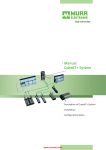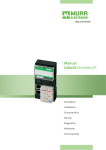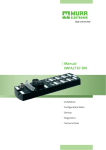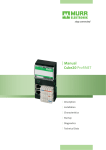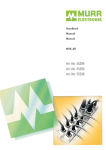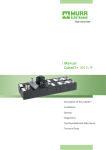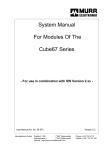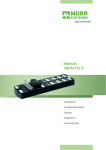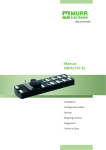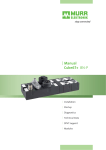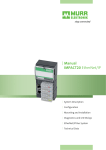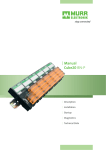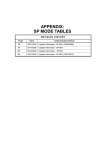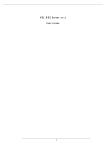Download Manual Cube20 System
Transcript
|Manual Cube20 System | Description | Installation | Configuration Notes | Diagnostics Cube20 System manual Publisher's Note Instruction manual for devices from the Cube20 product line General System Manual Version 1.3 Edition 07_11 EN Article number 56030 Murrelektronik GmbH Falkenstraße 3 D-71570 Oppenweiler Phone +49 (0) 7191 47-0 Fax +49 (0) 7191 47-130 [email protected] 2 Cube20 System manual Service and Support Website: www.murrelektronik.com In addition, our Customer Service Center (CSC) will be glad to assist you: Our Customer Service Center can support you throughout your project in the planning and conception of customer applications, configuration, installation, and startup. We also offer competent consulting or - in more complex cases - we even provide direct onsite support. The Customer Service Center provides support tools. It performs measurements for fieldbus systems, such as ProfiBus DP, DeviceNet, CANopen, and AS interface, as well as energy, heat, and EMC measurements. Our coworkers at the Customer Service Center provide their competence, know-how, and years of experience. They are knowledgeable about hardware and software, and compatibility with products made by various manufacturers. You can contact the Customer Service Center at telephone number +49 (0) 7191 47-424 or by email at [email protected]. 3 Cube20 System manual About the User Manual and its Structure 4 Cube20 System manual Here are links to the bus unser manuals: >>> PROFIBUS (www.profibus.com) >>> PROFINET (www.PROFINET.com) >>> ODVA (www.odva.org) 5 Cube20 System manual Table of Contents Publisher's Note ....................................................................................................................................... 2 Service and Support ................................................................................................................................ 3 About the User Manual and its Structure ................................................................................................. 4 Table of Contents..................................................................................................................................... 6 Important Information ............................................................................................................................... 9 1. Description of the Cube20 System .................................................................................................... 11 1.1 Picture of a Cube20 System Application ...................................................................................... 12 1.2 Explanation of the bus systems ................................................................................................... 12 1.3 The Cube20 System in the Bus Network ..................................................................................... 13 1.4 The Cube20/67 Interface Module................................................................................................. 13 2. Installation .......................................................................................................................................... 14 2.1 Mounting ....................................................................................................................................... 14 2.1.1 Dimensioning ......................................................................................................................... 14 2.1.2 Spacing .................................................................................................................................. 15 2.1.3 Mounting position .................................................................................................................. 15 2.1.4 Mounting Cube20 Modules on DIN rail and mounting the terminals ..................................... 16 2.1.5 Mounting the Potential Terminal Block on DIN rail and on the Cube20 Module ................... 17 2.1.6 Labeling of Terminals ............................................................................................................ 18 2.1.7 Terminal Wiring ..................................................................................................................... 19 2.2 Connection Diagram .................................................................................................................... 19 3. Configuration Notes ........................................................................................................................... 19 3.1 System Components .................................................................................................................... 20 3.1.1 Product Designation Code..................................................................................................... 20 3.1.2 Bus node................................................................................................................................ 21 3.1.3 I/O modules ........................................................................................................................... 22 3.1.4 Cube20/67 Interface, Art. No. 56140 ..................................................................................... 22 3.1.4.1 Topology ......................................................................................................................... 23 3.1.5 Accessories ........................................................................................................................... 24 6 Cube20 System manual 3.1.5.1 Potential terminal block ................................................................................................... 24 3.1.5.2 Label sheet ..................................................................................................................... 25 3.1.5.3 Coding pieces for terminals ............................................................................................ 25 3.1.5.4 Profibus connector .......................................................................................................... 25 3.1.5.5 BUS cable ....................................................................................................................... 25 3.1.5.6 Cable for Cube67 connection ......................................................................................... 26 3.1.5.7 Cable for Cube67 connection ......................................................................................... 26 3.1.5.8 MICO ............................................................................................................................... 27 3.2 Internal system connection .......................................................................................................... 28 3.2.1 Topology ................................................................................................................................ 28 3.2.2 Internal System Connection Terminations ............................................................................ 29 3.2.3 Maximum Expansion ............................................................................................................. 29 3.2.3.1 Cube20 BN ..................................................................................................................... 29 3.2.3.2 Cube20 BN67 DIO8 (Art. No. 56450) ............................................................................. 29 3.2.3.3 Cube20/67 Interface Module (Art. No. 56140) ................................................................ 30 3.2.4 Load rating ............................................................................................................................. 30 3.3 Power Supply ............................................................................................................................... 31 3.3.1 Configuration Notes ............................................................................................................... 31 3.3.2 Galvanic separation ............................................................................................................... 32 3.3.2.1 Information on the analog I/O modules........................................................................... 32 3.3.2.2 Information on the Cube20/67 interface module (Art. Nr. 56140) .................................. 32 3.3.3 Recommended power supply units ....................................................................................... 33 3.3.4 Cable Cross Sections ............................................................................................................ 34 3.3.5 Electromagnetic Compatibility (EMC) .................................................................................... 34 3.4 Connecting Sensors and Actuators.............................................................................................. 38 3.4.1 Sensor Supply ....................................................................................................................... 38 3.4.2 Supply of external components ............................................................................................. 38 3.4.3 Actuators................................................................................................................................ 38 3.5 Information about the data of the I/O modules ............................................................................. 40 4. Diagnostics ........................................................................................................................................ 41 7 Cube20 System manual 4.1 LED - Indicators............................................................................................................................ 41 4.1.1 Significance of the states of the "Power" LED....................................................................... 41 4.1.1.1 On the bus node ............................................................................................................. 41 4.1.1.2 Power LED on the I/O modules ...................................................................................... 43 4.1.2 (In the corresponding product manual!) Meaning of the "Bus Run" LED and the "Cfg F" LED states .............................................................................................................................................. 44 4.1.3 Displays for Supply Voltage at the Terminals of All Modules ................................................ 44 4.1.3.1 Module Supply ................................................................................................................ 44 4.1.3.2 Periphery Supply............................................................................................................. 45 4.1.4 Signal Logic State and LED Behavior ................................................................................... 46 4.1.4.1 Digital modules ............................................................................................................... 46 4.1.4.2 Analog Modules .............................................................................................................. 47 4.1.4.3 Cube20/67 Interface Module, Art. No. 56140 ................................................................. 49 4.2 (In the corresponding product manual!) Diagnostics via the Fieldbus ......................................... 49 Glossary ................................................................................................................................................. 50 Legal Provisions ..................................................................................................................................... 53 8 Cube20 System manual Important Information Necessary basic knowledge This manual contains general system information. For more detailed information please refer to the corresponding bus manuals and to the product manuals. Understanding this manual requires general knowledge in automation technology. Symbols and Icons This manual contains information and instructions you must comply with in order to maintain safety and avoid personal injury or damage to property. They are identified as follows: Notes indicate important information. Warnings contain information that, if you ignore this information, may cause damage to equipment or other assets or, if you fail to comply with safety precautions, may constitute a danger to the user's health and life. These instructions are recommendations issued by Murrelektronik. Intended Purpose Read this manual carefully before startup of the equipment. Keep it in a location that is accessible to all users at all times. The products that are described in this manual were developed, manufactured, tested, and documented in compliance with the relevant safety standards. In normal cases, these products do not constitute any danger to persons or objects, provided the handling specifications and safety instructions described in this manual are observed. They meet the following requirements: • EMC directive (2004/108/EEC) 9 Cube20 System manual The products are designed for industrial use. An industrial environment is defined as one in which loads are not connected directly to the public low-voltage power grid. Additional measures must be taken if the products are used in private, business, or trade environments. The safe, troublefree functioning of the products requires proper transportation, storage, mounting, and installation, and careful operation. Operation of the devices for their intended purposes is only guaranteed when the enclosures are fully mounted. If aggressive media are used, check their material resistance depending on the application. Current safety and accident prevention laws valid for a specific application must be observed for the configuration, installation, setup, maintenance, and testing of the devices. The power supply must correspond to SELV or PELV standards. Power sources in accordance with EN 61558-2-6 (transformer) or EN 60950-1 (switched-mode power supply) meet these requirements. Only use cables that meet the requirements and regulations for safety, electromagnetic compatibility, and, if necessary, telecommunications terminal equipment specifications. Information on the cables and accessories that are suitable for use with this product are contained in the section "System Components" of this manual. Qualified Personnel Only qualified, trained electricians knowledgeable in the safety standards of automation systems may configure, install, set up, maintain, and test the devices. The requirements concerning qualified personnel are dependent on the requirements profiles described in ZVEI and VDMA. For this reason, electricians must know the contents of the manual "Weiterbildung in der Automatisierung" (Further Training in Automation Systems) published by ZVEI and VDMA published by Maschinenbau-Verlag, Post Box 710864, 60498 Frankfurt, Germany) before installing and maintaining the devices. These are specialists who are capable of assessing the work to be done and the possible dangers on account of their technical training, knowledge, experience, and knowledge of the relevant standards; or who have an identical level of knowledge equivalent to technical training since they have worked in the same area for many years. Only Murrelektronik technical personnel are allowed to execute work on the hardware and software of our devices, if they are devices not described in this manual. Unqualified tampering with the hardware or software, or failure to observe the warnings cited in this manual may result in severe personal injury or damage to property. 10 Cube20 System manual 1. Description of the Cube20 System Murrelektronik Cube20 is a fieldbus I/O station with modular expandability. It is strictly oriented by the requirements of modern wiring in control cabinets. Due to its compact design Cube20 provides a very high channel density in a small space. This allows up to 488 I/Os on just 90 centimeters of DIN rail. All Cube20 modules are equipped with coded plug terminals for typical control cabinet 1-wire connectivity. Murrelektronik’s experience in electrical engineering shows that many control cabinets have up to 100 I/O points or more. Compared to the complex structure of I/O stations consisting of numerous individual components, Cube20 offers the advantage of lower installation costs and smaller profiles and its modular design does not leave many terminals unused. Moreover, using Cube20 has an impact on inventory and purchasing. It helps to significantly reduce the hidden costs caused by handling various individual components. Thanks to the expandability of Cube20, customers can choose from a variety of many digital and analog input and output models with universal applications. There are different bus nodes available for the connection to a higher-level system, therefore it is possible to exchange buses without changing the system. This is a great advantage for the designer: Customer-specific requirements can be realized in a simple and time-saving way. Cube20 can be operated as stand-alone unit at the fieldbus, and also in combination with Cube67. This allows an even more economic use of existing resources such as Cube67 bus nodes. It is possible to operate Cube67 modules on a Cube20 bus node by using a Cube20/67 interface module. Cube20 I/O modules are galvanically separated and have an integrated supply terminal. This simplifies the implementation of different potential groups. All Cube20 modules are equipped with a continuous, convenient diagnostic system as standard. LEDs light up precisely where the problem is; in addition a message is generated and sent to the control. This simplifies the first startup and allows pinpoint localization of sources of interference. This helps to significantly reduce downtime, increase productivity, and troubleshoot faulty components. 11 Cube20 System manual 1.1 Picture of a Cube20 System Application 1.2 Explanation of the bus systems For the descriptions of the different bus types please refer to the bus manuals. You will find an overview in the section "Manual Overview and Layout" in this manual. 12 Cube20 System manual 1.3 The Cube20 System in the Bus Network The Cube20 system is a modular I/O system with IP20 protection for decentralized collection and control of digital and analog process variables. It consists of a fieldbus specific bus node and I/O modules that are independent of the fieldbus and are connected to the bus node via an internal system connection. Fig. 1: Typical System Design 1.4 The Cube20/67 Interface Module The Cube20/67 interface module links the Cube20 System to the Cube67 System. The interface module is a passive module. It supplies no fieldbus diagnostic. A diagnostic is only possible using an LED display. It is possible to connect Cube67 modules to a Cube20 bus node by using a Cube20/67 interface module. Up to 15 Cube67 modules are connectable. However, the number of Cube20 and Cube67 modules may not exceed 15 modules. It is possible to connect the Cube20 BN67 DIO8 module, Art. No. 56450. The max. length of the Cube67 system cable is 10 m. The 0 V potential of the interface module must be tied to the bus node GND potential. 13 Cube20 System manual 2. Installation 2.1 Mounting 2.1.1 Dimensioning Fig. 2: Dimensioning 14 Cube20 System manual 2.1.2 Spacing Fig. 3: Spacing 2.1.3 Mounting position Fig. 4: Mounting position The potential terminal boxes can be mounted in any position. 15 Cube20 System manual REMOVE TERMINALS WIRING SNAP ON 2.1.4 Mounting Cube20 Modules on DIN rail and mounting the terminals Fig. 5: Mounting Cube20 Modules on DIN rail and mounting the terminals 16 Cube20 System manual 2.1.5 Mounting the Potential Terminal Block on DIN rail and on the CONNECT TO CUBE20 MODULES SNAP ON Cube20 Module Fig. 6: Mounting the Potential Terminal Block on DIN rail and on the Cube20 Module 17 Cube20 System manual 2.1.6 Labeling of Terminals The figures X0 to X3 indicate the up to 4 terminal rows, the top row always beginning with X0. terminal rows module supply analog channels digital channels periphery supply Fig. 7: Labeling of the terminals Below a short explanation of the terms: Module Supply • "UI" Supply voltage of internal supply. • "UA" (red): Actuator supply. • "GND": Module - Ground Periphery Supply • "US": Sensor supply. • "UA0…UA3" (brown): Actuator supply. • „0V“: 0 Volt Potential • : Function ground Digital modules • Inputs and outputs are labeled „00…03“ or „00…07“. Furthermore, the labeling corresponds to channel number and bit position. Analog Modules • Inputs and outputs are labeled „S0…S3", „U0…U3 and I0…I3", „+R0…+R3", „TH0+…TH3+" or also „KTY0…KTY1“. Furthermore, the labeling corresponds to channel number and bit position. 18 Cube20 System manual 2.1.7 Terminal Wiring Fig. 8: Terminal Wiring 2.2 Connection Diagram For the exact connection diagram and settings please refer to the corresponding product manuals. You will find an overview in the section "Manual Overview and Layout" in this manual. 3. Configuration Notes This chapter contains a short description of the Cube20 system components and information that is important during the electromechanical planning phase. 19 Cube20 System manual 3.1 System Components 3.1.1 Product Designation Code The designation format of Cube20 system components explains their function. Examples: Name CUBE20 Description BN-P DIO8 I/O Channels A D = Analog = Digital I O = Input = Output Fieldbus system BN = Bus node 67 P E/IP PNIO = Cube67 = ProfiBus = EtherNet/IP = ProfiNet Product family Fig. 9: Example Designation Code Name CUBE20 Description DI32 I/O Channels A D = Analog = Digital I O = Input = Output (a special function as e.g.: Interface Cube20/67 is also possible here) Product family Fig. 10: Example Designation Code 20 Cube20 System manual 3.1.2 Bus node The purpose of the Cube20 System is the decentralized routing of signals at the I/O level and the supply of this information over a fieldbus network (e.g. Profibus). The central unit is the bus node that connects the Cube20 I/O modules to the fieldbus. The bus node is supplied via the "UB" terminal; the BN67 is directly supplied via the internal system connection of Cube67. The bus node has a connection for the internal system connection that connects a maximum of 15 I/O modules or 3 I/O modules ("BN67"). The parts are linked together by plugging in the ribbon cable. Article number Description 56001 Cube20 BN-P DI8 56005 Cube20 BN-E/IP DI8 56006 Cube20 BN-PNIO DI8 56450 Cube20 BN67 DIO8 Tab. 1: Bus node For the exact connection diagram and settings please refer to the corresponding product manuals. Exception: "Cube20 BN67 DIO8 Art. No. 56450" which can be found as Cube67 connection in the Cube67 manuals. „Cube20/67-Interface Art. No. 56140“ which can be found as Cube20/67-Interface in the Cube20 product manual. You will find an overview in the section "Manual Overview and Layout" in this manual. 21 Cube20 System manual 3.1.3 I/O modules These modules are connected to the bus node via the internal system connection. Extension modules Extension modules are fitted out with an extension interface for the internal system connection, i.e. the latter can be routed to the following I/O modules. Up to four I/O modules can be connected to one segment. Attention! Only 3 I/O modules can be connected to the Cube20 BN67 DIO8, Art.No. 56450, (our Cube67 > Cube20 interface). An extension module can also be the sole or the last module of a segment. Article number Description 56112 Cube20 DI32 56117 Cube20 DO16 (2A) 56118 Cube20 DO32 56121 Cube20 DI32 NPN / PNP 56168 Cube20 DI16DO16 56200 Cube20 AI4 U/I 56201 Cube20 AI4 U/I 56220 Cube20 AO4 U/I 56221 Cube20 AO4 U/I 56230 Cube20 AI4 RTD 56240 Cube20 AI4 TH Tab. 2: Extension modules 3.1.4 Cube20/67 Interface, Art. No. 56140 The Cube20/67 interface module is a module that links the Cube20 System to the Cube67 System. The Cube20/67 interface module is not an active module. It is not parameterized and supplies no diagnostics. The module is fieldbus-independent but must always be linked to the bus node (BN) via the internal system connection. The power LED indicates the status of the internal Cube20 system link. The US and UA LEDs indicate the Cube67 status. Galvanically, UA and UI are at the same potential (0V). To avoid EMC-related impacts, the bus mode GND must be linked to the bus node 0V of the Cube20/67 interface module. 22 Cube20 System manual Article Number Description 56140 Cube20/Cube67 Interface 3.1.4.1 Topology Fig. 11: Example of a Cube20/67 interface module with 2 system topology variants Example VARIANT 1: Cube20 + Cube67 VARIANT 2: Cube20 + Cube20 1 Cube20 bus node + 4 Cube20 modules + 1 Cube20/67 interface module + 4 Cube67 modules = 10 modules 1 Cube20 bus node + 4 Cube20 modules + 1 Cube20/67 interface module + 1 Cube20 BN67 DIO8 M12 + 2 Cube20 modules = 9 modules Max. length of Cube67 system cables 10 m 23 Cube20 System manual Note on system topology with a Cube20/67 interface module: • A modular Cube20/67 fieldbus station can comprise up to 16 modules (Cube20 bus node + 15 Cube20/67 modules). • The Cube20/67 interface module is counted as a module and can be included in the configuration (but need not). • The Cube20/67 interface module can only be operated on Cube20 bus nodes and may only be used once in the station setup. • Only max. 3 Cube20 modules can be connected to the Cube20 BN67 DIO8 M12 Art. No. 56450. It is permitted to utilize the Cube20 BN67 DIO8 M12 Art. No. 56450 to connect to the Cube20/67 interface module Art. No. 56140. 3.1.5 Accessories 3.1.5.1 Potential terminal block Article number Description 56078 Potential terminal block gray / gray / brown / blue 56079 Potential terminal block gray / gray / yellow / blue 56080 Potential terminal block yellow / blue / yellow / blue 56081 Potential terminal block brown / blue / brown / blue 56082 Potential terminal block green / black / black / black / black 56109 Potential terminal block brown / brown / blue / blue 56110 Potential terminal block blue / blue / yellow / yellow 56111 Potential terminal block blue / yellow / brown / blue Tab. 3: Potential terminal block accessories 24 Cube20 System manual 3.1.5.2 Label sheet Article number Description 56113 Label sheet Tab. 4: Label sheet accessories 3.1.5.3 Coding pieces for terminals Article number Description 56115 Coding pieces for terminals Tab. 5: Accessories for terminal coding pieces 3.1.5.4 Profibus connector Article number Description 55585 Profibus plug with insulation displacement for rigid cables 55586 Profibus plug with insulation displacement for rigid cables and with programming connection 55587 Profibus plug with insulation displacement for flexible cables 55588 Profibus plug with insulation displacement for flexible cables and with programming connection Tab. 6: AccessoriesProfibus plug 3.1.5.5 BUS cable Article number Description 7000-00000-8409999 Bus cable for Profibus, 100 m bundle 7000-00000-7989999 Bus cable for ProfiNet CAT5, 100 m bundle 7000-00000-7989999 Bus cable for ProfiNet CAT5, 100 m bundle Tab. 7: BUS cable Most cables and connectors are available in angled style. 25 Cube20 System manual 3.1.5.6 Cable for Cube67 connection Cube67 system connection Article number Description 7000-46041-8020015 Male - straight / Female - straight green Cable length 0.15 m 7000-46041-8020030 0.3 m 7000-46041-8020060 0.6 m 7000-46041-8020100 1m 7000-46041-8020150 1.5 m 7000-46041-8020200 2m Tab. 8: Cube67 system connection 3.1.5.7 Cable for Cube67 connection Cube67 system connection Article number 7000-15001-4140150 Description Male - straight with open ended wires gray Cable length 1.5 m 7000-15001-4140300 3m 7000-15001-4140500 5m 7000-15001-4140750 7.5 m 7000-15001-4141000 10 m Tab. 9: Cube67 system connection We offer a wide product range of actuators / sensors. Connectors, cables, and adapters up to customized parts. 26 Cube20 System manual 3.1.5.8 MICO Article number Description Nominal operating branch-circuit current (full load) 9000-41034-0100400 MICO 4.4 (4 channels) 4 A each 9000-41034-0100600 MICO 4.6 (4 channels) 6 A each 9000-41034-0401000 MICO 4.10 (4 channels) 10 A each 9000-41042-0100400 MICO 2.4 (2 channels) 4 A each 9000-41042-0100600 MICO 2.6 (2 channels) 6 A each 9000-41042-0401000 MICO 2.10 (2 channels) 10 A each Tab. 10: Overview MICO variants Information on products and accessories is available in our catalog and our online shop at: onlineshop.murrelektronik.com 27 Cube20 System manual 3.2 Internal system connection ATTENTION: Inverting Cube20 I/O modules in a system can result in injury or serious damage to man and/or material. Therefore it is important, that Cube67 system cables and Cube67 I/O modules are clearly labeled. 3.2.1 Topology Fig. 12: Topology nFieldbus cable q Internal system connection (integrated) o Bus node r Supply: module, sensor, actuator p Expansion module s I/O The bus node has a connection for up to 15 I/O modules. It is not necessary to set the addresses of the modules. The modules are automatically addressed, according to their position. 28 Cube20 System manual 3.2.2 Internal System Connection Terminations No terminations required. 3.2.3 Maximum Expansion 3.2.3.1 Cube20 BN Up to 15 expansion modules can be connected to a Cube20 bus node. The parts are linked together by plugging in the ribbon cable. Fig. 13: Cube20 BN expansion 3.2.3.2 Cube20 BN67 DIO8 (Art. No. 56450) Up to 3 expansion modules can be connected to a Cube67 to Cube20 system expansion. The parts are linked together by plugging in the ribbon cable. Fig. 14: Cube67 to Cube20 system expansion In addition the requirements for the maximum expansion of the Cube67 system (system connection) have to be observed. They are described in the Cube67 or Cube67+ System Manual (art. no. 56970). 29 Cube20 System manual 3.2.3.3 Cube20/67 Interface Module (Art. No. 56140) Up to 15 modules can be connected to a Cube20 system expansion. The CUBE67 system cable is used as the electrical connection. Sensor and actuator power supply for the Cube67 modules is provided via the Cube20/67 interface. Refer to the requirements for maximum expansion of the Cube67 System (system link). You will find this in Cube67 or Cube67+ System Manual (Art. No. 56970). Note the sequence: It is not permitted to connect the Cube20/67 interface module Art. No. 56140 downstream of a Cube20 BN67 DIO8 Module Art. No. 56450. The max. length of the Cube67 system cable is 10 m. 3.2.4 Load rating It is not necessary to pay attention to the load of the internal system connection, because the I/O supply is connected directly to the corresponding I/O module. 30 Cube20 System manual 3.3 Power Supply 3.3.1 Configuration Notes Bus modules require a direct-voltage power supply of typically 24 VDC (SELV/PELV) which must comply with the regulations of conventional industrial power-utility companies. In order to optimize interference immunity, we advise you to power sensors, bus, and actuators from different sources. The power supply should be primary switchedmode or regulated power supplies. The output of the power supply units depends on the number of connected load and their output. In any case, it must be ensured that the system voltage does not drop below 18 V DC viewed from the system power supplies and measured at the remotest slave. System response becomes unspecific if sensor and bus power supply drop below 18 V DC. Primary switched-mode power supply units normally permit an increase in output voltage to the amount of the rated voltage in order to compensate for any power losses. Modules with digital inputs support the direct connection of commercially available sensors. A separate power supply may be necessary for the sensors if the total power required is high due to the number of slaves or a high power draw of the sensors. 31 Cube20 System manual 3.3.2 Galvanic separation Galvanic separation between the supply of the system supply and the sensor supply has to be provided. In order to maximize the electromagnetic compatibility we recommend to ensure galvanic separation. Fig. 15: Typical system structure with galvanic separation The illustration above shows a typical Cube20 system structure with digital inputs and outputs (DI/DO) and analog inputs and outputs (AI/AO). Furthermore it shows that Profibus, I/O area and I/O supply as well as the supply of the system electronics are galvanically separated. The internal electronics of the digital input/output modules are supplied by the system cable. The internal electronics of the analog input/output modules are supplied via the input/output supply voltage. 3.3.2.1 Information on the analog I/O modules. The I/O supply voltage must always be connected, otherwise communication via the internal system connection is interrupted starting from the analog module that is not supplied. 3.3.2.2 Information on the Cube20/67 interface module (Art. Nr. 56140) Galvanically, the supply voltages UA and UI are at the same potential (0V). Galvanically, connected Cube67 modules are not separated from the module electronics of the Cube20 System. 32 Cube20 System manual 3.3.3 Recommended power supply units Primary switched-mode power supply units from Murrelektronik are specially designed to power automation systems. For this reason, we recommend them to power the modules. Note for DeviceNet users: We recommend so-called Class 2 power supplies for the supply of the DeviceNet bus. Please contact our sales support regarding information about "ODVA" certified power supplies. Phases Output rating Input voltage 95...132 V AC Input voltage 185...265 V AC 1 240 W / 10 A 85086 85085 1 480 W / 20 A 85088 85087 Tab. 11: Recommended power supply units MCS Power+ single phase Phases Output rating Input voltage 3 x 340...460 V AC 3 240 W / 10 A 85095 3 480 W / 20 A 85097 3 960 W / 40 A 85099 Tab. 12: Recommended power supply units MCS Power+ three phase Murrelektronik offers an extensive range of primary switched power supply units. Please refer to our catalogs or: www.murrelektronik.com 33 Cube20 System manual 3.3.4 Cable Cross Sections Fig. 16: Cable cross sections 3.3.5 Electromagnetic Compatibility (EMC) This device meets the requirements of EC Directive 89/336/EEC "Electromagnetic Compatibility". This device is Class A equipment and may cause radio-frequency interference in residential areas. In this case, the operator may be required to implement adequate countermeasures. The devices described in this manual each meet the relevant standards for electromagnetic compatibility. However, this does not mean that their electromagnetic compatibility is still guaranteed when installed in a plant or machine. For this reason, we urgently advise you to comply with the instructions on installation in accordance with EMC requirements below. Only then can you assume that the overall system complies with EMC requirements, provided CE-marked components are used exclusively. Protection against Electrostatic Discharge The products described in this manual contain complex semiconductor components which may be destroyed or damaged by electrostatic discharge (ESD). Damage does not necessarily lead to immediate, detectable failure, or malfunction. These states may be even delayed, or occur sporadically. The generally accepted safety precautions for ESD sensitive devices must be observed when handling the devices. The following precautions must be taken: 34 Cube20 System manual Never plug or unplug connectors while the equipment is under power. If you are an operator, discharge any static charge you may be carrying just before you touch the equipment. For example, you can touch a grounded part of the machine, or wear an ESD discharge strap that is permanently connected to ground. Grounding A short (as short as possible), low-impedance connection between the grounding point and the reference ground is essential to divert interference voltages running between the device and reference ground. The inductivity of standard FE conductors is a high impedance for high-frequency interference voltages. For this reason, the use of grounding straps is advisable. If this is not possible, a fine-wire FE conductor should be selected with the largest possible cross section, and the connection to ground should be kept as short as possible. Cable Routing You can avoid EMC problems by observing elementary basic rules of cable routing: • Route data lines as far as possible away from power lines. • Route data lines and power lines at least 10 cm apart. • Intersect data and power lines at right angles only. • Route data and power lines in separate, shielded compartments. • Remember the interference potential of other devices or lines when routing the cables. • Place frequency converters, motor lines, and other devices and lines that emit high-frequency interference at the greatest possible distance. Voltage Drops Short-term voltage drops (<10 ms) normally pose no operational problems as the electronics are protected by capacitors integrated in the power circuits. This does not apply to the power supply of the sensors and actuators connected to the module. Their high power requirement cannot be covered by the capacitors integrated in the device. For this reason, even transient interruptions of the actuator supply can result in undesirable switching operations. 35 Cube20 System manual Due to the integrated input filter, a change in the input signal of less than 1 ms does not cause a change of the input state signaled to the Master. Longer interruptions of the sensor supply may cause changes of the input signal. Separate Power Supplies Sensors or actuators can be powered by a common power supply unit. However, it is preferable to use separate power supplies in order to maximize the electromagnetic compatibility of the overall system. Interference Suppression of Inductive Loads The outputs of the devices described in this manual have an integrated protective circuit that provides safety against high-energy interference voltages, such as those that occur when inductive consumers are switched. Inductive load (e.g. solenoid valves) Varistor or bipolar suppressor diode Fig. 17: Interference Suppression of Inductive Loads A suppressor diode helps to quickly reduce the energy stored in the inductive load of a magnetic field. However, it is recommended to use commercially available protection circuits for inductive loads, especially loads in the range of the maximum current-carrying capacity of a channel at switching frequencies of > 1 Hz. These protection circuits can reduce the energy stored in the connected inductances. The high voltages that occur when inductive loads are shut down result in strong fields in the cables with consequential faults in adjacent circuits or devices. Murrelektronik offers a wide selection of interference suppression products for this purpose. Please refer to our catalogs or: onlineshop.murrelektronik.com 36 Cube20 System manual Other Measures and Limits In some system configurations, the requirements for interference emission and immunity from interference can only be met with additional measures, or even not at all. In these cases, the EMC within the system is also dependent on the single components of other manufacturers. Mains filters are a suitable means of reducing line-conducted interference. Various manufacturers offer optical-fiber converters. This data transmission technology is basically immune to EMC interferences. However, this does not apply to the electronic conversion circuits. For this reason, the use of optical fibers does not solve all EMC problems. Our certified test center will answer your questions regarding EMC. They will give advice on guaranteeing compliance with the EMC directive for the system you produce. Murrelektronik Test Center, Grabenstraße 27, D-71570 Oppenweiler Phone ++7191 47-334, Fax ++7191 47-323, [email protected] 37 Cube20 System manual 3.4 Connecting Sensors and Actuators Attention: Cube20 modules are no safety-related devices according to the relevant standards. The Off-status of the outputs must not be used to meet safety-related requirements of the application! 3.4.1 Sensor Supply Sensors can be supplied by the I/O module. The sensor supply of each module is secured by an electronic, self-resetting fuse. The max. current draw for the sensor supply is 0.7 A for each module. There is no derating for the sensor supply. WARNING! The capacity per digital input is 10 nF. 3.4.2 Supply of external components The actuator supply (not switchable) for the analog output modules is provided. For each UA0...UA3 terminal (brown), 1.6 A current are available. 3.4.3 Actuators Please see the corresponding Instruction manual for the maximum current that can be taken from the outputs. Information about derating: • AO modules do not have derating. • For DO modules, the following derating curves are applicable, if all outputs are switched at the same time. 38 Cube20 System manual Derating DO for 0.5 A Fig. 18: Derating curve of the DO modules for 0,5A Derating DO for 2 A Fig. 19: Derating curve of the DO modules for 2A ATTENTION: The module may be damaged if the actuator power supply polarity is reversed. To increase power, outputs may be connected in parallel. If an overload or short-circuit occurs at an output, that output is shut down. This output will remain disabled even when the error has been corrected. In order to reset the short-circuit memory, the output must be reset or the actuator supply switched off. 39 Cube20 System manual 3.5 Information about the data of the I/O modules By means of the device identification the fieldbus master gets information about the data capacity, operation mode, etc. for peripheral modules (I/O modules). After having detected the slaves the master generates from this data a map of all detected I/O modules of the bus system. The data of the I/O modules are mapped in a list according to the logical arrangement in the fieldbus. The user can now map the entries of the bus master list to addresses in the PLC. This will create the process image of the inputs and outputs (PII/PIO). PLC Fieldbus I/O Modules Fieldbus Master Periphery Image „Inputs“ Process Image Inputs (PII) Master Node 1 Input Data Node 1 Diagnosis Data Node 1 • Input Data • Diagnosis • Output Data Input Data Node 2 Diagnosis Data Node 2 Input Data Node 3 Diagnosis Data Node 3 Bus SPS program Master Node 2 • Input Data • Diagnosis • Output Data Periphery Image “Outputs” Output Data Node 1 Output Data Node 2 Output Data Node 3 Bus Process Image Outputs (PIO) Master Node 3 • Input Data • Diagnosis • Output Data Fig. 20: Data transfer between PLC, fieldbus master and bus devices Data transfer between PLC, fieldbus master and bus devices For the module specific I/O data, please refer to the corresponding product manuals. You will find an overview in the section "Manual Overview and Layout" in this manual. 40 Cube20 System manual 4. Diagnostics 4.1 LED - Indicators 4.1.1 Significance of the states of the "Power" LED 4.1.1.1 On the bus node The "Power" LED indicates the status of the Cube20 system voltage and the internal communication. Fig. 21: Example Power LED on Cube20 Modules 41 Cube20 System manual Behavior of the Power Led of Cube20 BN Modules Color Significance for Power LED green System voltage (>12V) available Green flashing System connection in the Cube20 system is interrupted, no. of flashing pulses corresponds to the position of the faulty expansion module (1…15), with several modules the closest one Remedy Replacement of the affected module and power reset at terminal UB of the Cube20 BN module Example: off No system power (<12V) Increase voltage Tab. 13: Behavior of the Power Led of Cube20 BN Modules 42 Cube20 System manual 4.1.1.2 Power LED on the I/O modules The "Power" LED indicates the status of the Cube20 system voltage and the internal communication. Fig. 22: Example Power LED on Cube20 Modules Behavior of the Power LED of Cube20 I/O modules Color Significance for Power LED fast flashing (approx. 20Hz) System power available and module exchanging data off No system power via the Cube20 system connection Remedy • Wait for initialization of the Cube20 system (can take some seconds) • Check the internal system connection (ribbon cable) and power reset at terminal UB of the Cube20 BN module Tab. 14: Behavior of the Power LED of Cube20 I/O modules 43 Cube20 System manual Verhalten der Power-LED an Cube20/67-Interface-Modulen Farbe Bedeutung für Power LED Abhilfe grün UI und Weiterschaltung vorhanden Funktion i.O. aus UI fehlt oder Initialisierung läuft • • UI muss vor dem Starten des Cube20 Systems anliegen. Initialisierung des Busknotens kann einige Sekunden in Anspruch nehmen Tab. 15: Verhalten der Power-LED an Cube20/67-Interface-Modulen 4.1.2 (In the corresponding product manual!) Meaning of the "Bus Run" LED and the "Cfg F" LED states They are described in the Cube20 product manuals. For an overview please refer to the beginning of this manual, chapter "About the User Manual and its Structure". 4.1.3 Displays for Supply Voltage at the Terminals of All Modules 4.1.3.1 Module Supply There is no LED at terminal "UB". The state of system voltage is signalized by the Power LED. See chapter: Significance of the states of the "Power" LED • Indicators with „UI“ show the state of the supply voltage for the internal supply. • Indicators with „UA“ show the state of the supply voltage for actuators. 44 Cube20 System manual LED indicator UI and UA Response State green Supply voltage OK (>= 18V) Red Under voltage (< 18V) off Voltage <= 12.5V Tab. 16: LED Module Supply 4.1.3.2 Periphery Supply • Indicators with „US“ show the state of the supply voltage for sensors. • Indicators with „UA0…UA3“ show the state of the supply voltage for actuators. LED Display US and UA Response State off Supply voltage OK Red Overload or short circuit of the sensor or actuator supply Tab. 17: LED Periphery Supply Two terminals each have one common "US" LED. 45 Cube20 System manual 4.1.4 Signal Logic State and LED Behavior 4.1.4.1 Digital modules A separate status indicator is assigned for each input and output. It is labeled with "00…03" or "00…07". Furthermore, the labeling corresponds to channel number and bit position. It is situated under the corresponding terminal and allows easy mapping to the state of the peripheral components, sensors and actuators. Connection of signal logic state and LED behavior at the input LED Display Logical value Voltage at input Signal off 0 0V NO input Yellow 1 24 V Tab. 18: LED at Input of Digital Modules Connection of signal logic state and LED behavior at the output LED Display Logical value Voltage at output Signal off 0 0V Output Yellow 1 24 V Red 1 0V Output in case of short-circuit Tab. 19: LED at Output of Digital Modules When inductive loads are switched off, the diagnostic LED on the output channel of modules 56118 and 56168 may light up briefly. This does not represent a module malfunction. The module does not sustain any damage. 46 Cube20 System manual 4.1.4.2 Analog Modules A separate status indicator is assigned for each input and output. The corresponding LED is situated under the respective terminal. Cube20 AI4 U/I Art.-No.: 56200 / 56201 The terminals are labeled with the channel numbers "S0…S3". LED Display State Possible diagnostics off OK - Red Diagnostics • Line break • Measuring range overshot • Measuring range undershot Tab. 20: LEDs of the Channels of the Analog Modules Cube20 AI4 U/I Art. No.: 56200 / 56201 Cube20 AO4 U/I Art.-No.: 56220 / 56221 The terminals are labeled with the channel numbers "U0…U3" and "I0…I3". LED Display State Possible diagnostics off OK - Red Diagnostics • Line break • Actuator short circuit Tab. 21: LEDs of the Channels of the Analog Modules Cube20 AI4 U/I Art. No.: 56200 / 56201 47 Cube20 System manual Cube20 AI4 RTD Art.-No.: 56230 The terminals are labeled with the channel numbers "+R0…+R3". LED Display State Possible diagnostics off OK - Red Diagnostics • Line break • Measuring range overshot • Measuring range undershot Tab. 22: LED of the channels of the analog module Cube20 AI4 RTD Art.-No.: 56230 Cube20 AI4 RTD Art.-No.: 56240 The terminals are labeled with the channel numbers "TH0+…TH3+". LED Display State Possible diagnostics off OK - Red Diagnostics • Line break • Measuring range overshot • Measuring range undershot • Wire break cold junction compensation (KTY) Tab. 23: LEDs of the channels of the analog module Cube20 AI4 TH Art.-No.: 56240 48 Cube20 System manual 4.1.4.3 Cube20/67 Interface Module, Art. No. 56140 Significance of the US / UA Cube67 LED on the M12 socket: LED Display Response green State Voltage connected through for Cube67 modules (up to US > 6V). red Short-circuit or overload on Cube67 System. Same as Cube67 system link. off US / UA not available. Modules not yet initialized. Tab. 24: US / UA Cube67 LED at M12 socket 4.2 (In the corresponding product manual!) Diagnostics via the Fieldbus These diagnostics depend on the fieldbus. Please refer to the corresponding instruction manual of the bus node (BN) used. For an overview please refer to the beginning of this manual, chapter "About the User Manual and its Structure". 49 Cube20 System manual Glossary Actuator shutdown "Short circuit or overload at an output causes the output to switch off." AI Analog Input AO Analog Output BN-P Bus Node - Profibus, bus node - Profibus Bus-Run-LED LED that signals the bus status Bus segment "Due to the electrical specification of the RS-485 interface, the number of users on an RS485 network is limited to 32 users. If there are more than 32 Profibus users, the network must be divided into segments by means of repeaters." Byte Term from IEC 61158. Corresponds to 1 Byte or 8 bits. Cfg F-LED LED to signal a correct/incorrect configuration DI Digital input DIN TH35 DIN standard mounting rail (35x15mm, 35x7.5mm) DO Digital Output DP" Decentralized periphery. Profibus protocol for rapid cyclical data exchange." E/A(I/O) Input/output - EC Directive 2004/108/EEC EMC directive EMC Electromagnetic Compatibility ESD Electrostatic discharge FE Function ground Freeze Command The input data of the slave are "frozen". GSD The Device Master Data describes the technical features of a Profibus product. This file is required to configure a Profibus system and is provided by the device manufacturer." 50 Cube20 System manual I Current I/O- Input/ Output ID number "A 16-bit number that identifies a Profibus product uniquely. It represents a reference for the GSD file. Several devices have the same ID number, provided they are described in a common GSD file. This number is awarded by the Profibus user Organization. IEC 61158 Worldwide standard for Profibus DP and FMS. Successor of international standard EN 50170, Volume 2." IP20 Ingress Protection, 20 = Device protection against the ingress of solid foreign bodies measuring a diameter of more than 12.5 mm (finger protection), the device is not protected against ingress of water with deleterious impacts. LSB Least significant bit LWL Optical fiber MSB Most significant bit. Ni Nickel PAA Process map of outputs PAE Process map of inputs PELV Protective Extra Low Voltage PNO Profibus User Organization. Power-LED LED to signal the operating status Pt 100 Electrical resistance 100W of a platinum wire at 0°C +R High potential sensor connection. -R Low potential sensor connection. Repeater Coupling element to process signals between Profibus segments. RL Sensor power supply in three-wire mode. RTD Resistance Temperature Device. S Reference potential SELVSafety Extra Low Voltage. Simatic Manager Programming software for program-logic controllers made by Siemens PLC Program-logic controller 51 Cube20 System manual TH Thermocoupler TH- Low potential sensor connection. TH+ High potential sensor connection Type E, Type J, Type K, Type N, Type R Thermoelements as per DIN EN 60584 standard. U Voltage U/I Voltage / current UA (brown terminal) Actuator power supply UA (red terminal) Module power supply UB Operating voltage. UI (red terminal ) Module and sensor supply US BROWN sensor supply VDMA Verband Deutscher Maschinen- und Anlagenbau e.V. (Association of German Machinery and Industrial Equipment Manufacturers) VZ Sign. ZVEI Zentralverband Elektrotechnik- und Elektronikindustrie e.V. (German Electrical and Electronic Manufacturers' Association). 52 Cube20 System manual Legal Provisions Exclusion of Liability Murrelektronik GmbH has checked the contents of this technical documentation for conformity with the hardware and software described therein. Changes on an individual case basis cannot be excluded. For this reason, Murrelektronik gives no warranty for the correctness of the contents and refuses any liability for errors, in particular for complete conformance. For this reason, Murrelektronik excludes the warranty for the correctness of its contents and any liability for errors, in particular full conformity. Should a major contractual obligation be violated by criminal negligence, the liability of Murrelektronik GmbH shall be limited to damages that typically arise. Subject to technical changes and alternations in content. We advise that you check at regular intervals whether this documentation has been updated since corrections that may become necessary due to technical advances are included by Murrelektronik GmbH at regular intervals. We are gratefully for any suggestions for improvement. Copyright It is prohibited to transfer or photocopy the documentation either in paper or in digital form, reuse or divulge its contents unless otherwise expressly permitted by Murrelektronik GmbH or in conjunction with the production of documentation for third-party products that contain products made by Murrelektronik GmbH. Violations will result in liability for damages. All rights reserved, in particular in the event of the award of patents or granting of utility models. Right of Use Murrelektronik GmbH grants its customers a non-exclusive right revocable at any time and for an indefinite period of time to use this documentation to produce their own technical documentation. For this purpose, the documentation produced by Murrelektronik GmbH may be changed in parts, or amended, or copied ,and transferred to the customer's users as part of the customer's own technical documentation on paper or on electronic media. The customer shall then bear sole responsibility for the correctness of the contents of the technical documentation produced by him. If the technical documentation is integrated in part, or in full in the customer's technical documentation, the customer shall refer to the copyright of Murrelektronik GmbH. Furthermore, special attention shall be paid to compliance with the safety instructions. Although the customer is obliged to make reference to the copyright of Murrelektronik GmbH, provided the technical documentation of Murrelektronik GmbH is used, the customer shall market and/or use the technical documentation on his sole responsibility. The reason is that Murrelektronik GmbH has no influence on changes or applications of the technical documentation and even minor changes to the starting product or deviations in the intended applications may render incorrect the specifications contained in the technical documentation. For this reason, the customer is obliged to identify the technical documentation originating from Murrelektronik GmbH if and inasmuch as the documentation is changed by the customer. The customer shall be obliged to release Murrelektronik from the damage claims of third parties if the latter are attributable to any deficits in the documentation. This shall not apply to damages to the rights of third parties caused by deliberate or criminal intent. The customer shall be entitled to use the company brands of Murrelektronik GmbH exclusively for his product advertising, but only inasmuch as the products of Murrelektronik GmbH are integrated in the products marketed by the customer. The customer shall refer to the brands of Murrelektronik GmbH in an adequate manner if the brands of Murrelektronik GmbH were used. 53 Murrelektronik GmbH|Falkenstraße 3, D-71570 Oppenweiler|P.O. Box 1165, D-71567 Oppenweiler Phone +49 7191 47-0|Fax +49 7191 47-130|[email protected]|www.murrelektronik.com The information in this manual has been compiled with the utmost care. Liability for the correctness, completeness and topicality of the information is restricted to gross negligence.






















































